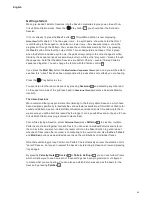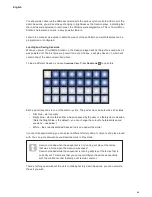
35
English
Programming a Pattern
To program a synth Pattern in Paraphonic Mode 1 (the default), first select a Patch as described
in “Selecting Patches” on page 33. Enter
Note View
for Oscillator 1 (press
Note
and then
Osc
1
if not already selected).
To assign a note to a Pattern step, press and hold the pad for the step – it will turn red – and
simultaneously press the pad for the note to be assigned, which will also turn red while it is
being pressed. For example, if you want your Pattern to start with the scale root note (which will
be C unless you’ve changed it) on beat 1 of the Pattern, press and hold Pad 17 (the first step
in the Pattern) and then press Pad 9. When you run the sequence, the note of C will now play
on step1 of the 16-step Pattern. You can add further notes to other steps in exactly the same
way. Note that once notes have been assigned to steps, the pads for those steps will illuminate
bright blue.
Note that the two
Octave
buttons
13
have no effect on the pitch of the notes once they’ve been
recorded; you need to decide which octave you’re going to play in at the time of recording.
However, you can still alter the octave of the pattern after recording by holding down
Shift
when pressing
Octave
.
The two parameters in
Scales View
– Scale and Root Note – can both be altered during
playback as well, so if you like the pattern, but it’s in the wrong key to fit with another musical
element, you can just press
Scales
and select a different root note.
Using Paraphonic Mode 2 (see “Paraphonic voicing” on page 26), exactly the same
procedure can be used to program Steps for Oscillator 2.
Step editing
Step editing operations in Circuit Mono Station may either be done with the pattern running (i.e.,
in Play mode), or not running (i.e., in Stop mode).
Circuit Mono Station gives you the means of adding or deleting individual notes in a pattern
without needing to worry about accurate timing, as editing is step-based and doesn’t require
the notes to be accurately entered.
All the following details apply equally – and independently - to Osc 1 and Osc 2. Press the
Osc 1
or
Osc 2
buttons to see the individual contributions of the two Tracks to the overall
pattern. Bear in mind the need to select Paraphonic Mode 2 – by pressing
Shift
+
Scales
- to
hear the Pattern assigned to Oscillator 2.
In
Note View
(but not
Expanded Note View
), the two lower rows of grid pads represent the 16-
step pattern and the two upper rows are the performance pads. When a pattern is played, you
can see the white pad moving through the 16 steps. When a step has a note associated with it,
the performance pad in the two upper rows corresponding to the note being played illuminates
white while the note is sounding (but see the following page regarding octaves).
When the pattern is not playing, you can listen to the notes assigned to each step and alter the
pattern manually. When the pattern is playing, you will only hear the notes associated with each
step when the sequence gets to the step.
Содержание Circuit Mono Station
Страница 1: ......
Страница 93: ...93 English...
















































